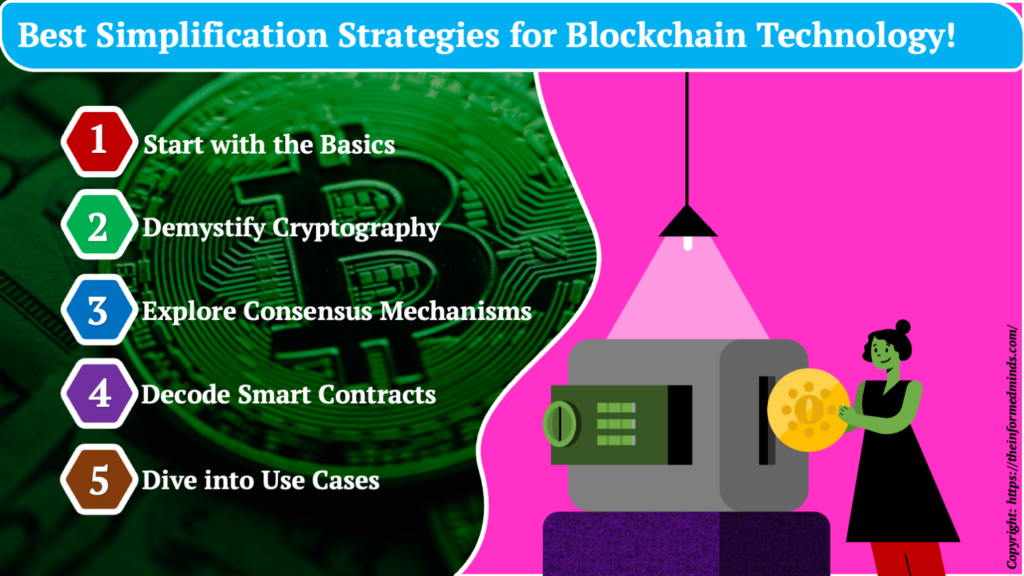To Share is to Show You Care!
In the rapidly evolving world of technology, blockchain has emerged as a revolutionary concept, promising secure and transparent transactions. However, its intricate nature can sometimes deter newcomers. Fear not! This comprehensive guide will unveil the most effective strategies to simplify blockchain technology and make it accessible for everyone.
1. Understanding the Complexity
Blockchain technology, often hailed as the cornerstone of cryptocurrency, operates on a decentralized network. Its complexity arises from cryptographic puzzles, consensus mechanisms, and distributed ledgers. While these features ensure security, they can pose a steep learning curve. Blockchain technology, often celebrated as the cornerstone of cryptocurrencies, operates on a decentralized network. Its complexity arises from a combination of cryptographic puzzles, consensus mechanisms, and distributed ledgers. Let’s explore further,
- Cryptographic Puzzles: These complex puzzles ensure the security of transactions by making them computationally intensive to solve.
- Consensus Mechanisms: These are protocols that ensure agreement among network participants regarding the validity of transactions. Examples include Proof of Work (PoW) and Proof of Stake (PoS).
- Distributed Ledgers: The blockchain maintains a distributed, tamper-proof ledger of transactions across multiple nodes, adding another layer of complexity.
2. Mastering Simplification Strategies
Simplifying blockchain technology doesn’t mean compromising on its integrity. Here’s how to navigate this intricate landscape with ease

2.1 Start with the Basics

- Grasp the fundamental concept of blockchain as a chain of interconnected blocks, each containing data.
- Understand the decentralized structure that eliminates the need for intermediaries, making transactions more secure and efficient.
- Dive into the concept of blockchain’s chronological order of blocks to understand its structure.
- Explore the role of miners or validators in adding new blocks and maintaining consensus.
- Discuss the importance of immutability and how blocks are linked using cryptographic hashes.
2.2 Demystify Cryptography
- Break down complex cryptographic techniques into simpler terms. For instance, explain how hash functions create unique identifiers for data.
- Learn about public and private keys: Public keys act as addresses, while private keys allow access to digital assets.
- Illustrate the concept of a digital signature as a way to ensure the authenticity of transactions.
- Explain the concept of a “wallet” as a combination of public and private keys.
- Explore how asymmetric cryptography forms the basis of secure communication on the blockchain.

2.3 Explore Consensus Mechanisms

- Delve into various consensus algorithms like Proof of Work (PoW) and Proof of Stake (PoS).
- Comprehend their roles in validating transactions and maintaining the blockchain’s integrity. Explain the energy-efficiency advantages of PoS.
- Investigate newer consensus mechanisms like Proof of Authority (PoA) and Practical Byzantine Fault Tolerance (PBFT).
- Discuss the concept of finality in blockchain consensus and how it ensures irreversible transactions.
- Examine hybrid consensus models that combine different algorithms for improved scalability and security.
2.4 Decode Smart Contracts
- Uncover the potential of self-executing contracts on the blockchain.
- Introduce Solidity, the programming language used for creating smart contracts, and discuss its importance in automating processes.
- Elaborate on the role of oracles, which bring external data into smart contracts.
- Discuss the potential of blockchain interoperability, allowing smart contracts to work across different blockchains.
- Explain the concept of self-executing code in smart contracts and its impact on automation.

2.5 Dive into Use Cases

- Explore real-world applications of blockchain beyond cryptocurrencies.
- Discuss how blockchain enhances supply chain transparency, facilitates cross-border payments, secures healthcare records, and more.
- Explore blockchain’s potential in mitigating fraud and ensuring transparency in voting systems.
- Discuss the concept of tokenization, turning physical assets into digital tokens on the blockchain.
- Highlight blockchain’s role in creating decentralized identity systems for enhanced security and privacy.
3. Unlocking Simplicity
By following these strategies, you can unravel the complexity surrounding blockchain technology. Please see below.
- Break down intricate concepts into digestible chunks.
- Utilize analogies to relate blockchain to everyday scenarios (e.g., comparing blockchain’s decentralized ledger to a shared Google Doc).
- Leverage online tutorials, courses, and interactive platforms to enhance learning.
- Engage with blockchain communities and forums to seek assistance and share insights.
Here are some of the use cases and real time examples on how we can simplify blockchain technology,
3.1 Strategy: Utilize Analogies to Explain Decentralization

Decentralization, a fundamental concept of blockchain, can be tricky to grasp. Imagine it as a community garden where everyone has a key to the gate, and each gardener maintains a copy of the garden’s plan. No one person can make changes without agreement from others, ensuring the garden’s integrity. Similarly, in blockchain, each participant holds a copy of the ledger, preventing a single entity from altering records without consensus.
3.2 Strategy: Relate Smart Contracts to Vending Machines

Smart contracts might seem complex, but think of them as digital vending machines. When you insert the right coins (input), the machine automatically dispenses your chosen snack (output). In the same way, a smart contract executes predefined actions when specific conditions are met. For instance, a smart contract could release payment to a freelancer only after they deliver the completed work, eliminating the need for intermediaries.
3.3 Strategy: Break Down Hash Functions with Puzzles

Explaining hash functions can be puzzling, but consider them as virtual jigsaw puzzles. Just as each puzzle piece fits together uniquely, a hash function generates a unique code for each set of data. This code acts like a puzzle piece, forming the blockchain’s structure. When the puzzle is complete (data is added to the block), the code confirms its authenticity. This way, every piece of the puzzle (data) has a distinct place in the grand picture (blockchain).
Remember, simplifying blockchain is all about finding relatable parallels that make the technology more accessible and understandable.
4. Crushing Complexity
Here are some final tips to conquer the complexities of blockchain. Please see below,
- Stay updated with the latest advancements and trends through reputable sources and news outlets.
- Practice hands-on by experimenting with blockchain platforms or simulated environments.
- Collaborate with peers to exchange insights, troubleshoot challenges, and collectively expand knowledge.
- Embrace a growth mindset: Understand that mastering blockchain takes time, and be patient with the learning process.
5. Conclusion
Blockchain technology, despite its initial complexity, is within your grasp. By adopting the strategies outlined in this guide, you can journey from confusion to clarity. Remember, the path to mastery begins with the first step of simplification. Unlock the doors to blockchain’s potential and embrace the future of technology with confidence. Remember, it’s all about unlocking simplicity in the complex world of blockchain. Happy simplifying!
6. Frequently Asked Questions
Q1: What is the strategy of Blockchain technology?
A: The strategy of Blockchain technology involves simplifying its complex concepts through strategies like utilizing analogies, breaking down cryptographic processes, and exploring various consensus mechanisms.
Q2: What is the Blockchain technology simplified?
A: Blockchain technology simplified is a way to make the intricate world of blockchain accessible by explaining it through relatable analogies, demystifying cryptography, and breaking down consensus mechanisms.
Q:3 What is the best consensus algorithm for blockchain?
A: The best consensus algorithm for blockchain depends on the specific use case. Proof of Stake (PoS) and Proof of Work (PoW) are commonly used algorithms, each with its advantages and limitations.
Q4: What are the solutions to scaling blockchain?
A: Solutions to scaling blockchain include techniques like sharding, layer 2 solutions (e.g., Lightning Network), and exploring consensus mechanisms designed for scalability, such as Delegated Proof of Stake (DPoS).
Q5: What are the 5 key forces of Blockchain technology?
A: The five key forces of Blockchain technology are decentralization, transparency, security, immutability, and efficiency.
Q6: What are the three pillars of Blockchain technology?
A: The three pillars of Blockchain technology are decentralization, transparency, and security.
Q7: What are the different types of Blockchain technology?
A: Different types of Blockchain technology include public, private, and consortium blockchains. Public blockchains are open to everyone, private blockchains are restricted, and consortium blockchains are shared among selected participants.
Q8: How do you explain Blockchain technology to a child?
A: Imagine a digital diary that many people can write in, but no one can change what’s written. This diary is stored in many places so no one can destroy it. That’s like Blockchain, a safe and unchangeable way to keep track of things.
Q9: What are the core components of the blockchain?
A: The core components of the blockchain are blocks (records of data), cryptographic hashes (unique identifiers), and a decentralized network of participants who validate and add new blocks.
Q10: What is the main algorithm in blockchain?
A: The main algorithm in blockchain depends on the type of blockchain. Proof of Work (PoW) and Proof of Stake (PoS) are two common algorithms used for consensus.
Q11: Which algorithm is used in blockchain?
A: Blockchain uses various algorithms, with Proof of Work (PoW) and Proof of Stake (PoS) being among the most common for achieving consensus.
Q12: What are the two commonly used consensus models in blockchain?
A: Two commonly used consensus models in blockchain are Proof of Work (PoW) and Proof of Stake (PoS).
Q13: How do I make my blockchain more scalable?
A: To make your blockchain more scalable, consider techniques like sharding (splitting data processing), using layer 2 solutions (off-chain transactions), and exploring consensus mechanisms designed for scalability.
Q14: What technique is used to improve scalability of blockchain?
A: Sharding and layer 2 solutions are techniques used to improve the scalability of blockchain. Sharding divides the workload, and layer 2 solutions move transactions off the main chain.
Q15: What are scaling strategies?
A: Scaling strategies refer to approaches used to enhance the capacity and efficiency of a blockchain network, such as sharding, off-chain solutions, and optimizing consensus algorithms.
The Informed Minds
I'm Vijay Kumar, a consultant with 20+ years of experience specializing in Home, Lifestyle, and Technology. From DIY and Home Improvement to Interior Design and Personal Finance, I've worked with diverse clients, offering tailored solutions to their needs. Through this blog, I share my expertise, providing valuable insights and practical advice for free. Together, let's make our homes better and embrace the latest in lifestyle and technology for a brighter future.

